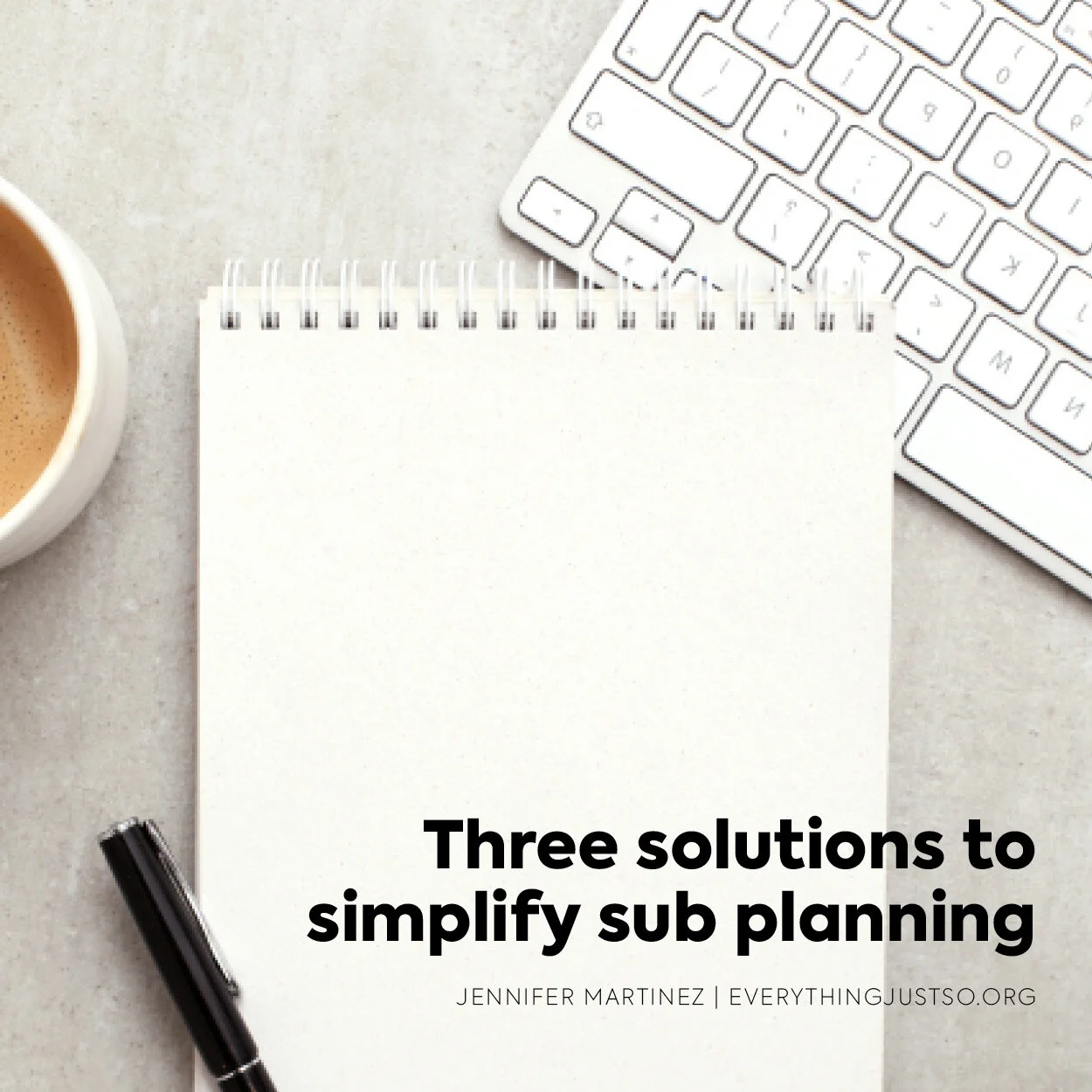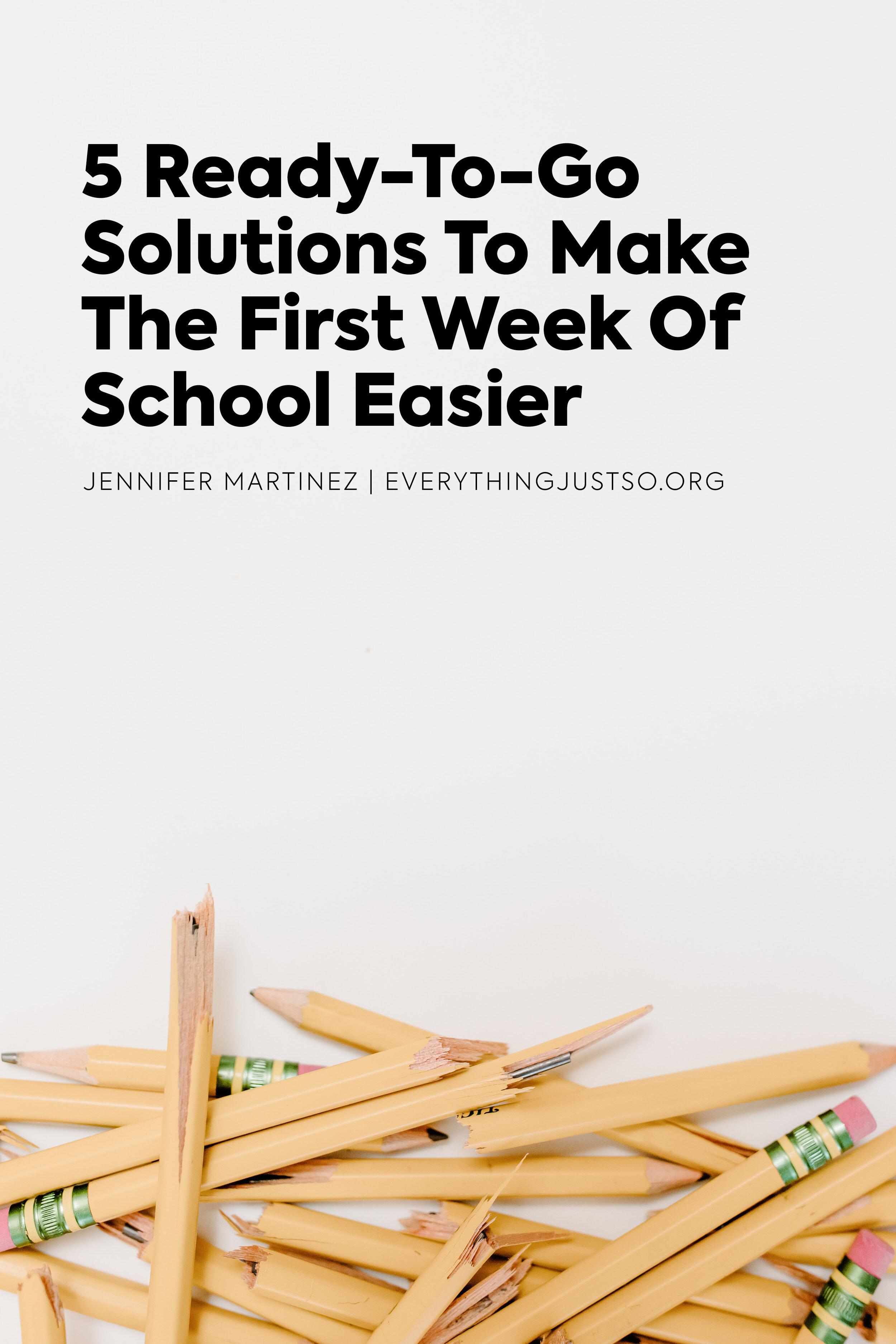Three Solutions That Will Make Sub Prep Simple
It's inevitable. You wake up and feel like death warmed over. Or your child has been up all night sicker than a dog.
Or perhaps your car dies before school while waiting in the Starbucks drive through (this actually happened, friends).
Whatever the reason, you have to be out of the classroom and need a sub unexpectedly.
Planning to be out is never easy, but scrambling to throw together lesson plans for a sub you weren't expecting is far worse.
There are three things you can do now to make planning for a sub easier. Even better, each of these steps can be completed over the summer so that you are well prepared from day one of the school year.
This post contains affiliate links. This means, should you make a purchase using a link, I earn a small amount at no extra cost to you. The earnings help cover the cost of this site.
Three Ways to Simplify Planning for a Substitute
1 | Have a sub binder
In one of my buildings, this was a requirement. Each teacher was given a notebook with dividers and a list of specific information that must be included inside. After using it a couple of times, I couldn't understand why this wasn't required in every school.
Besides being helpful for subs, it was a huge time saver for me.
If you don't already have a sub binder, I encourage you to create one. If you don’t want to create your own, I have one for you. All you’ll need to do is simply enter your info and add your plans. You can find my sub binders and teacher planners here.
While not exhaustive, here's a list of what I included in mine:
General building information:
Notes about items specific to your building (if your sub will need a key to use the staff bathroom, explain where she can find a spare key, etc.)
Policy on computer use by substitutes (special log-in and password, etc.)
Fire and tornado drill procedures and locations of where to take students
Fire drill class list check sheet
School behavior plan policy and notes on how to utilize it
Classroom and routine specific items:
Your daily schedule
Staff who work with you (intervention specialists, teacher aides, volunteers, etc. and when they come to your room)
Explanation of morning routines (taking attendance and lunch counts, student work, etc.)
Procedures for how students rotate usage of laptops, computers, or other devices
Policy on "bring your own devices" and using them during class
Procedures for lining up as a class and walking in hallways
Procedures for using the restroom (sign out sheets, how many students can go at a time, etc.)
Procedures for checking out books during open checkout in the library or going book shopping in your classroom
Where to find indoor recess games
Rules for indoor recess (must students stay in your classroom or are they able to visit other rooms?)
Routines for collecting finished work, where to put incomplete work
Expectations for grading student work (would you like for the sub to grade an assignment or leave it for you?)
Where to find extra student supplies (pencils, paper, sticky notes, glue sticks, etc.)
Where to find other important supplies (band-aids, materials for cleaning up spills, incentive bucks, etc.)
A quick overview of how to use technology such as a SmartBoard, document camera, etc. if your plans include using them
End of the day routines (how students pack up to go home, classroom jobs, etc.)
Student information:
Class lists with notes on each student (their personality, who they work well with and/or should be separated from)
Seating chart
List of student health concerns and notes on how to handle each (students with allergies, diabetics who receive shots, students with physical disabilities, etc.)
List of students who can serve as teacher helpers
Incentives for or how to track positive behavior (Class Dojo, reward bucks, treasure box, etc.)
Notes on students with behavior plans and helpful tips for managing possible disruptions
List of how students get home (walkers, car riders, and those who ride the bus)
Notes about items specific to certain students (Johnny goes to lunch bunch on Wednesday, the green group goes to read with Mrs. Smith's class at 12:00, the speech therapist will pick up Sally at 10:00, etc.)
Other helpful information:
Frequently used numbers (front office, nurse, counselor, principal, etc.)
Who to contact when you need help (team members' names, phone numbers, and room locations)
Building map with frequently visited places highlighted (teacher workroom, staff bathroom, cafeteria, specials classes, etc.)
Explanations of duties (recess or cafeteria monitor, bus duty responsibilities, etc.)
Your copier code
Where to get a cup of coffee in the morning or a Coke in the afternoon
Lunch options for staff
Just in case info:
Emergency sub plans (see number three below)
Procedures for welcoming a new student and where you keep new student materials
Special events, schedules, or assembly information (where to take students for an assembly, alternate schedules for late arrival and early dismissal days, etc.)
To make the binder even more helpful, include as many pictures as possible.
For example, I would often have substitutes misuse our behavior binder and assign more tallies than necessary or record them in the wrong place. To help solve this issue, I took a picture of a section from a completed tally page in my discipline binder, inserted the image into the behavior section of the sub binder, and then wrote captions explaining certain parts.
The visual was a great help and I rarely experienced issues after incorporating into the binder.
I created a printable checklist for you to use as you’re setting up your own binders. You can find it in The Treasury.
2 | Create a lesson plan template
The lesson plans I left for substitutes were detailed and extensive. Oftentimes, they would be five to six pages long, or more. I spent hours typing up procedures and plans for what I wanted to happen while I was out.
Having a sub binder greatly reduced the time spent typing those plans as I no longer had to include notes on aspects that didn't change - how to take lunch counts, what students should do when they arrive in the morning, etc.
However, I still spent a great deal of time narrating specific portions of lessons.
To help remedy this, I created a complete narrative of a typical day and saved it to my computer at school, on my flash drive, and to GoogleDocs. This way, I could access the document no matter where I was and whether or not I had access to the Internet. When I needed to be out, I simply modified the document to include that day's specific activities and then emailed it to a colleague who would print out the plans and leave on my desk for the substitute.
While it seems like only common sense, it took a couple of years into my career before I took the time to do this. It was always one of those things I had on my perpetual to-do list, but was never a priority until I needed to be out.
When I finally created a template, I made the mistake of saving it only on my school computer. This meant that I had to drive in to school on the day I needed to be out and then spend a bulk of time in the building completing it.
Kind of negates the point of calling off.
Don't be like me and leave this step parked on your to-do list. Get it done now - you'll thank yourself the very first time you need to be out!
3 | Prepare emergency sub plans
This is a genius idea I wish I had thought of during my first year of teaching.
Not only will there be days that you'll need to be out unexpectedly, but there will also be times when your absence will be longer than just one day. To save you the stress of writing plans for multiple days when you're already not feeling well, have several days worth of complete plans ready to go at the beginning of the school year.
Over the summer, take the time to plan out a week's worth of lessons that your students can complete at anytime. Type up a narrative version of your plans for each day using your substitute lesson plan template and then collect the resources your sub and students will need in each part of the lesson. Run class sets of each resource and bundle together with the daily plan.
When you return to your classroom in the fall, place the bundled lessons and resources in a visible place. Tell a teammate (or two) where your sub binder and emergency plans are located so that they can help your substitute settle in any time you're out.
If you don't want to create resources from scratch, look for ready-made resources that include lesson plans with student resources and extend over several days.
In my store, I have several such resources that would work well as emergency sub resources including "St. Patrick and The Emerald Isle."
While it was created with St. Patrick's Day in mind, it is a complete non-fiction resource on Ireland, Northern Ireland, and St. Patrick that can be used any time throughout the year.
You can find it and several others in my "Emergency Sub Plan" section of my store.
Within your emergency plans, remember to include a list of extra "filler" activities that substitutes can use in case your lessons go quicker than planned.
These meaningful activities require little teacher guidance and can be completed by students independently, in pairs, or small groups. Next to each item, be sure to explain where to find specific materials in your classroom.
A few ideas:
Catch up on back issues of Scholastic magazines and accompanying activities
Have students reflect and give thanks for acts of kindness with monthly, themed writing prompts
Time for extra independent or buddy reading with Independent Reading Response Task Cards
Complete "I Recommend" forms and post to the classroom board
Center activities including practicing spelling words
Online extension activities, such as ScootPad
"Positive News" updates
Refresh book boxes with extra time to go book shopping
Clean out desks and organize folders/binders
Catch up on unfinished work
Write thank you notes
Utilizing these three steps will have you well prepared for any absence this year - planned or unplanned. Not only will sub planning in advance alleviate a great deal of stress for you, but it ensures students are left with meaningful and engaging activities. Win-win.
Have you found ways to make planning for a substitute easier? Please share what works for you! Next week we tackle the topic of organizing all of your teaching resources.
If lesson planning, in general, is a struggle for you, be sure to read this post on how to simplify your own lesson planning. To start from the beginning of the series, click here.
LOOKING FOR MORE HELP?
If you’re looking for step-by-step instructions for completing the tips shared here, be sure to check out my Planned Just So™ course. It’s the only planning course of its kind that teaches you step-by-step how to create a year-long instructional plan, design units that are aligned to your standards and keep students engaged, and provide you with tips for making your overall planning routine as simple as possible.
In my course, you will go from feeling stuck and overwhelmed to feeling empowered and in control as you learn the systematic process of creating lesson plans that increase rigor for your students and free time for yourself.
Planned Just So™ will transform your professional life and help you reclaim your personal life. Learn more here.
Click the image below to save these ideas for later…














